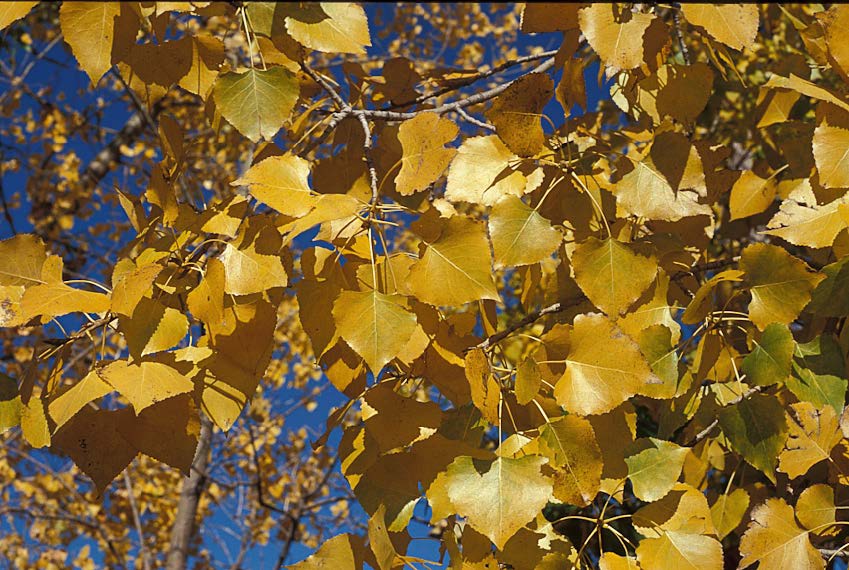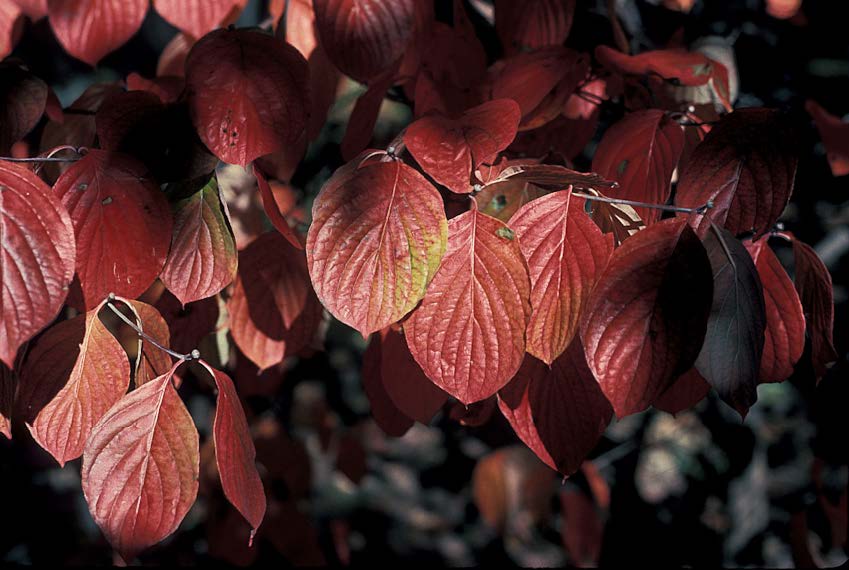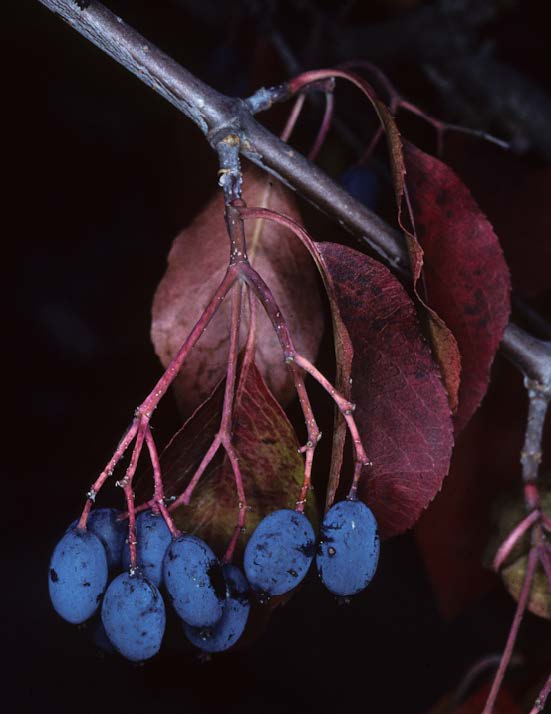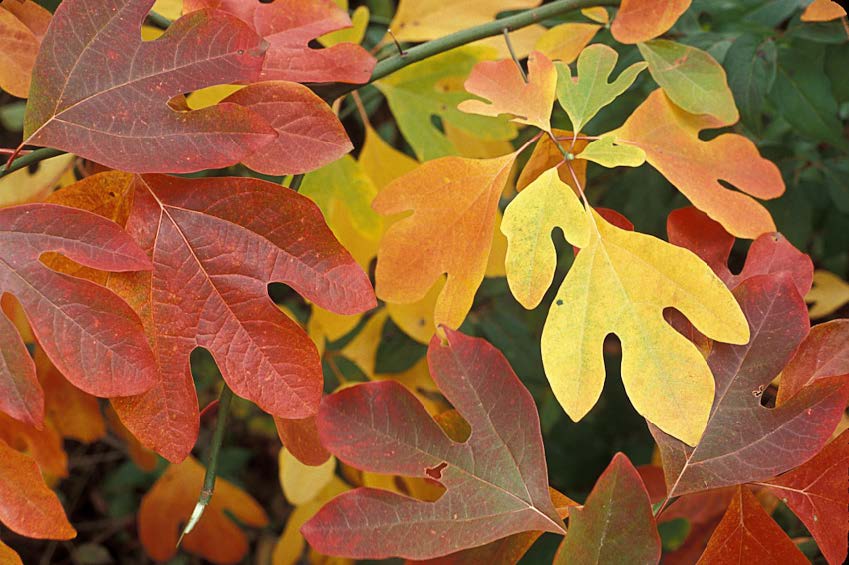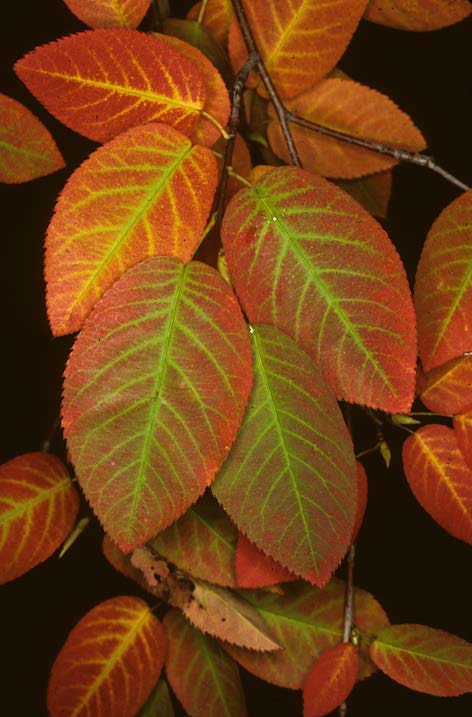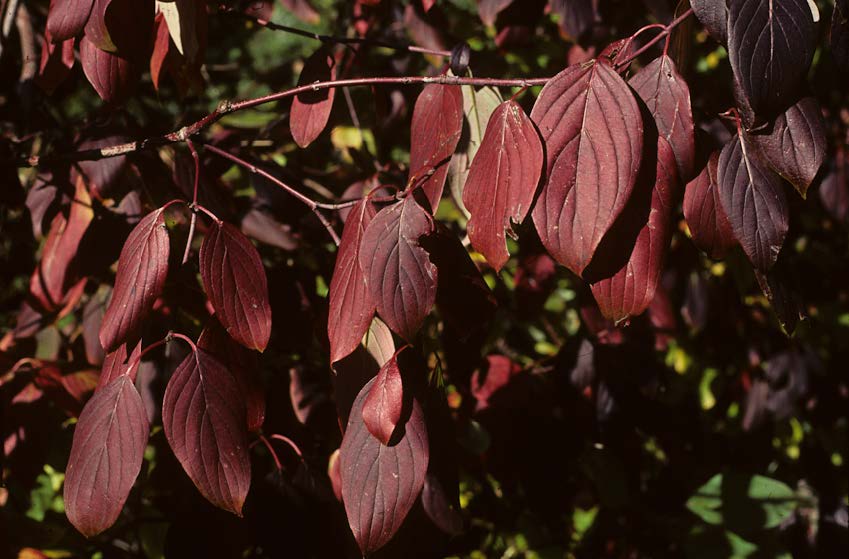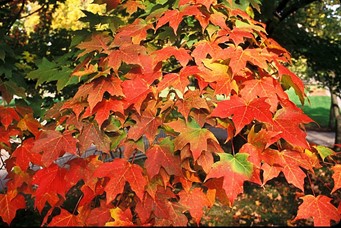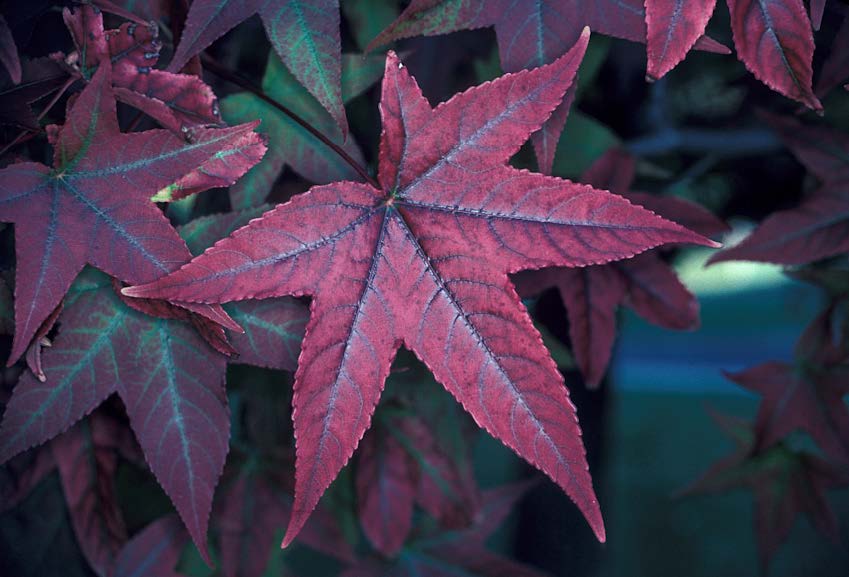Environmental Information Series
CNY Fall Colors
By Dr. Donald Leopold
Three main ingredients lead to spectacular fall color display: species that have the potential to turn intense color, ideal weather (i.e., sunny and dry conditions, cool nights), and large landscapes that are either rather uniform or have an interesting blend of textures like an mixture of deciduous and evergreen trees and array of topographic features. All of these ingredients blend perfectly in many locations throughout New York.Upstate New York is an outstanding place to embark on fall color journeys. Besides the many local parks and natural areas, and roadside stands of trees central New York, some of the most beautiful of New York’s 152 state parks and 700,000 acres of state forests are in our region. There are another 70 major NYS-‐DEC Wildlife Management and Multiple Use Areas that offer over 167,000 acres of outdoor opportunities throughout the state (but be careful leaf gawking during hunting season), many not a far drive away. Willing to drive further? The 6 million acre Adirondack and 650,000-acre Catskill Parks and Forest Preserve can be enjoyed even in one day.
Over 125 tree species are native or naturalized in New York, but not all contribute to fall foliage coloration. Evergreens, while they provide superb contrast, of course play no direct role, but one native conifer (i.e., cone-‐bearing tree), the eastern larch or tamarack, is probably the last tree species to turn color (golden yellow) in upstate New York and the Adirondacks. Dozens of native, deciduous (i.e., trees that lose their foliage in the fall) trees reliably make a splendid contribution to fall colors, e.g., sweetgum (orange red to purple), yellow-‐poplar (yellow fall color), sassafras (reddish-‐orange), hickories (yellow-‐gold), white and red oaks (reddish brown), American beech (brownish-‐bronze), paper and gray birch (yellow), American hornbeam (reddish-‐bronze), eastern cottonwood (golden yellow), quaking aspen (golden yellow), bigtooth aspen (reddish orange), Kentucky coffeetree (golden yellow), serviceberry (reddish-‐orange), blackgum (scarlet-‐purple), pin cherry (fire red), flowering dogwood (reddish-‐orange), alternate-‐leaf dogwood (burgundy), white ash (purple-‐red-‐ orange), green ash (yellow), nannyberry (purple-‐red), and numerous maples that include black (orange-‐red), striped and silver (yellow), red (yellow to red), mountain (orange-‐ bronze-‐red), and of course our state tree, sugar maple (orange-‐red).
Many shrub species also provide splendid fall color displays. Staghorn sumac (scarlet-‐red-‐orange)
and gray dogwood (purple-‐red) are especially prominent in old fields throughout
the upstate. Combined with the many blooming native asters (blue, purple, and white
flowers) and goldenrods (golden yellow flowers), the display is striking. Spicebush
(yellow) and silky dogwood (deep purple-‐red) are common in wetlands. Black chokeberry
(orange-‐red-‐scarlet), poison-‐sumac (red-‐orange), black huckleberry (scarlet
purple), and highbush blueberry (orange-‐red-‐scarlet) occur in other upstate wetlands.
Many of these and other vivid wetland shrub species occur along the boardwalks at
Labrador Hollow Unique Area and Beaver Lake Nature Center. Witch-‐hazel (yellow),
found in many dry and wet forests, also blooms (yellow, strap-‐like flowers) while
reaching its peak fall colors.
Maple-‐leaf viburnum (pale pink tones) occurs in many dry forests.
Two common, naturally occurring vines, poison-‐ivy and Virginia creeper, have intense colors each fall (both orange-‐red to scarlet-‐deep purple) as they climb up into tree canopies and cover fences and roadside hedgerows. But be aware that poison-‐ivy is no less a problem to susceptible people, even if its leaves are not green.
The fall color display in New York just gets better every year as trees that colonized or were planted on eroded, abandoned agricultural land in the early 1900’s begin to mature. Today, New York is nearly 70% forested, a significant amount of forested land compared to the roughly 20% that existed in the state in the early 1900’s, and a tremendous amount compared to the 5-‐10% forested landscape of most regions in the Midwest. A very high percentage of the trees that naturally colonized these exhausted farmlands are some of the best for fall color, e.g., sugar maple, white ash, and quaking and bigtooth aspens.
While over 125 tree species naturally occur in New York, there are relatively few
widely recognized, natural groupings, or “forest types” of these species. Northern
hardwoods and oak-‐hickory are the generally the most colorful forest types in the
autumn, especially the northern hardwoods type, in which one of the most beautiful
trees in autumn anywhere, the sugar maple, is a dominant tree. In fact, about 20%
of all the forest trees in New York are sugar maple. It is primarily the northern
hardwood forest type that makes the Northeast famous for its fall colors, and much
of central New York has fine stands of this type. If the burning colors of the northern
hardwood type are too much, check out the various reds, bronzes, rich browns, golds,
and yellows of the oak-‐hickory forest, especially prominent in the southern half
of the state. The elm-‐ash-‐soft maple forest type, of the state’s lake plain,
tends to be one of the least colorful forest types in the state. But some of the swamps
dominated by red maple and occasional blackgum in this region are quite stunning each
fall.
Some of the most incredible fall color comes from tree species that are widespread
throughout the state, e.g., red maple, or found in young forests like quaking aspen
and paper birch. Some other outstanding trees for fall color are rather infrequent
statewide, but may be locally abundant, like blackgum, which few people ever notice
until mid October while travelling by swampy areas throughout central New York. The
north side of the Thruway heading east from Syracuse to Oneida, is a fine area for
thickets of blackgum.
Some memorable color displays are by individual trees and shrubs in stark settings,
e.g., a shrubby red maple or quaking aspen emerging from a crack in a rock. Also rewarding
on a small scale, are astonishing contrasts of leaves of various trees at peak color
floating on the bluish-‐green water at Green Lakes, or the softened colors in the
reflection of trees in the lake at Clark Reservation in mid to late October .
There are also many beautiful non-‐native (to New York) trees to view in the autumn that are used as street trees or planted in parks or other green spaces, e.g., yellowwood (golden yellow), honeylocust (golden or bright yellow), buckeyes (bronze-‐orange), Chinese dogwood (orange-‐deep red), katsuratree (apricot-‐yellow), Norway maple (golden yellow), Japanese maple (deep red), Amur maple (scarlet red orange), baldcypress (reddish bronze), eastern redbud (yellow), flowering pears (deep purple to orange red), and ginkgo (golden yellow). Sweet cherry (orange-‐red) and common pear (deep red to purple) add terrific color to many hedge rows in upstate New York.
While weather is the primary factor that determines variation in fall color from
year-‐to-‐year; latitude, elevation, local site conditions, and tree species determine
the timing of fall color development within any year. Some tree species like red maple,
begin showing color in late summer. In fact, the wetlands on either side of I-‐81
from Tully to Preble are packed with stunted red maples that reach their peak fall
color in late August to early September. Sugar maple and other species will develop
much color in late summer if they are drought stressed, a common phenomenon for many
tree species along streets of Syracuse where recent summer droughts and heavy salt
loads gradually kill many sensitive tree species. But they put on a nice show before
they succumb. Under average weather conditions in central New York, white ash is one
of the first tree species to reach peak color in early fall; quaking aspen, Norway
maple, and larches don’t reach their peak color until the last week of October or
even later in central New York. Leaf colors in the flowering pears (e.g., ‘Bradford’,
‘Aristocrat’) peak in mid to late November, often with a covering of snow.
Fall colors peak first at higher latitudes and higher elevations in the state, so the red maples will often reach their maximum color intensity in mid to late September in the Adirondacks, but the third week of October in central New York. The earliest fall color show in the state is in the High Peaks region of the Adirondacks where the views are breathtaking, even before fall colors intensify.
Time of day and sunlight intensity also can have a dramatic influence on fall colors.
For example, walk through Oakwood Cemetery an hour or two just after sunrise or before
sunset, when the sun is low on the horizon and the sun’s rays add extra reds and oranges
to the already brilliant sugar maples. A background of dark skies will really enhance
the colors.
One doesn’t have to travel great distances to enjoy fall colors. A list of local natural
areas for viewing excellent fall color is really a list of the impressive array of
city greenspaces and county and state parks in this region (all are open to the public
and have walking trails). In Syracuse, perhaps the greatest variety of trees with
good fall color and that are also most accessible for viewing can be found in Oakwood
Cemetery, including large red and white oaks, hickories, yellowwood, sugar maple,
Japanese maple, Amur maple, redbud, katsuratree, flowering dogwood, sassafras, yellow-‐poplar,
ginkgo, and baldcypress. Rand Tract (“Valley” of Syracuse) has very diverse topography,
a large number of tree species (including sassafras, oaks, yellow-‐poplar, bigtooth
and quaking aspens, red and sugar maples, flowering dogwood, hickories) and some that
are of exceptional size. Elmwood, Heath, and Thornden city parks have a large number
of tree species that are worth searching for each fall. Even some streets provide
some marvelous fall colors, e.g., the green ash planted along the section of Comstock
south from Euclid has a fine display of golden yellow each year.
Truly outstanding natural areas to visit anytime, but especially in mid to late October, are just a short distance away (15-40 minute drive) from Syracuse. Clark Reservation State Park has unique glacial features including a small lake, a diverse mix of evergreens and deciduous trees, and an exceptional view. Green Lakes State Park has two beautiful bodies of aquamarine colored water and a diversity of evergreens and deciduous trees (some of which are of exceptional size). The falls and creek at Chittenango Falls State Park are especially beautiful when framed by the many color trees each fall. A very nice short drive is on I-‐481 to Fulton, where one passes striking red maples (especially in Clay Marsh), large patches of quaking aspen and sassafras, and scattered blackgums along with dense stands of sugar maple and white ash.
Three NYS-‐DEC Unique Areas are also near Syracuse: Camillus Unique Forest (large areas of colorful old fields, outstanding mature forest dominated by sugar maple, sweeping views towards the city, Labrador Hollow/Tinker Falls (water, wetlands, uplands, waterfall, interesting geology, diverse mix of evergreens and deciduous trees, incredible view from Jones Hill), and Nelson Swamp (some very colorful deciduous tree species mixed with many beautiful evergreen species). Additionally, Cicero Swamp NYS-DEC Wildlife Management Area is a very large and wild area just north of Hancock Airport. The portion that burned over 100 years ago in the north center area of the swamp is now a black spruce/tamarack forest with thousands of golden tamarack in late October through early November, and many other colorful wetland trees and shrubs (including poison-‐ sumac!) from mid September through early November). One caution though: do not visit during hunting season (unless hunting).
Any one of these three county parks would be the envy of most counties in the East: Beaver Lake, Pratts Falls, and Highland Forest. All of these parks have excellent hiking trails and access to a large number of trees that are quite colorful each autumn. Not far away from Beaver Lake is Whiskey Hollow, with many tree species more common to the central Appalachians like flowering dogwood, sassafras, yellow-poplar, and chestnut oak, among sugar maples and other tree species. Also in Onondaga County, Baltimore Woods has many large sugar maples along with a diversity of other richly hued tree and shrub species, in a beautiful steep ravine setting surrounded by open fields that include much staghorn sumac.
A one to two hour drive can transport one into some of the most scenic areas of upstate New York. The state parks in the region around Ithaca, e.g., Buttermilk Falls and Taughannock Falls State Parks, have spectacular gorges, water falls, and many tree species. Not far to the west are extensive trails and roads through the nation’s smallest national forest, the Finger Lakes National Forest, which also happens to be in the heart of wine country. Is there be a more enjoyable day looking at fall colors and visiting some of the many excellent wineries throughout this region? At the southern end of Seneca Lake is Watkins Glen Gorge and State Park.
The Sterling Nature Center on bluffs near the shoreline of Lake Ontario offers excellent trails through fields and forests. Perhaps the most awe-‐inspiring place on the Lake Ontario shoreline is the Chimney Bluffs State Park (just east of Sodus Bay), where Lake Ontario has greatly eroded the glacial drumlins near the shoreline. The scattered cottonwoods and pin cherries that cling to these massive, ant mound-‐like structures are amazing to see, especially at peak fall color. There are dozens of state forests within a one-‐ hour drive from Syracuse, especially north and south.
Less than a two hour drive away, the Thousand Islands region offers scenery that few places in the East can match. The majestic St. Lawrence River, in this region dotted with nearly 2000 islands of various sizes, is even more grand when the red maples and other deciduous trees throw their colors against the picturesque evergreens on many of the islands. Wellesley Island State Park is a fine place to explore this region, or one can take a boat ride that starts on either side of the River. Before the snows start to accumulate, a near wilderness experience and outstanding fall colors can be had by travelling throughout the Tug Hill Plateau. Whetstone Gulf State Park is especially noteworthy for the first time visitor to this area. Just to the northeast of Utica and on the southern edge of the Adirondacks, the forests on both sides of West Canada Creek are as rewarding for their fall colors as the creek is for its trout fishing.
Just over two hours away by car one can visit the “Grand Canyon of the East” at Letchworth Gorge State Park. Although the vistas here are breathtaking any day of the year, fall colors really liven the views, and hint at the interesting diversity of trees.
Perhaps the real show though is about a three hour drive away, into the Catskill and Adirondack Parks and Forest Preserves. These regions are dissimilar in their fall color displays primarily because the Catskills have more oak and hickory dominated forests and the Catskills are at lower latitudes (and elevations) than the Adirondacks. But both regions offer views that few places in the East can match, relative to extent of unbroken forest landscape and the very best tree species for fall color. The Adirondacks have more of the fall color species associated with New England, e.g., sugar maple, paper birch, yellow birch, and quaking aspen. Of all the trees in the Adirondacks, I think that the sugar and red maples, quaking and bigtooth aspens, and eastern larches make this region most memorable each fall. A drive into either region during fall color season will disappoint no one. If possible, hike a trail to a firetower or mountain overlook, where even the most strenuous effort will be richly rewarded. But there are many stunning views that require only a modest physical effort, and others, like the drive up Whiteface Mountain, which require no effort at all.
Really want to see an extended fall color season? Travel to the Adirondacks, especially
the High Peaks region in late September and early October for the peak color there,
visit some of the many closer places the rest of October, then travel to the Catskills
towards the end of October. Regardless of where you go, try to visit at least one
new place each year. There are dozens of books available to help discover new hiking
trails, bicycle routes, canoe trips, and fishing outings. A New York State Atlas and
Gazetteer will open up staggering options for exploration throughout the state. Most
places in Upstate New York will likely reward those searching for special spots to
see fall colors.
|
Alternate Leaf Dogwood |
American Beech |
American Hornbeam |
Bigtooth Aspen |
Bitternut Hickory |
|
Black Huckleberry |
Black Maple |
Blackgum |
Eastern Cottonwood |
Flowering Dogwood |
|
Gray Birch |
Gray Dogwood |
Green Ash |
Highbush Blueberry |
Honey Locust |
|
Kentucky Coffeetree |
Mountain Maple |
Nannyberry |
Northern Red Oak |
Norway Maple |
|
Paper Birch |
Pin Cherry |
Pin Oak |
Poison Ivy |
Poison Sumac |
|
Quaking Aspen |
Red Maple |
Sassafras |
Service Berry |
Shagbark Hickory |
|
Silky Dogwood |
Silver Maple |
Spicebush |
Staghorn Sumac |
Striped Maple |
|
Sugar Maple |
Sweetgum |
Tamarack |
Virginia Creeper |
White Ash |
|
White Oak |
Witch Hazel |
Yellow Birch |
Yellow Poplar |
Yellowwood |









